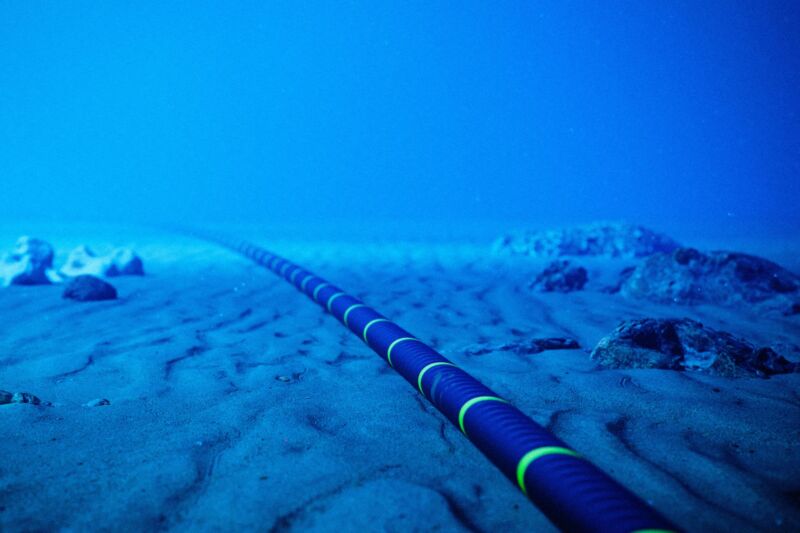
The Asia-Africa-Europe-1 Internet cable travels 15,500 miles along the seafloor, connecting Hong Kong to Marseille, France. As it snakes through the South China Sea and toward Europe, the cable helps provide Internet connections to more than a dozen countries, from India to Greece. When the cable was cut on June 7, millions of people were plunged offline and faced temporary Internet blackouts.
The cable, also known as AAE-1, was severed where it briefly passes across land through Egypt. One other cable was also damaged in the incident, with the cause of the damage unknown. However, the impact was immediate. “It affected about seven countries and a number of over-the-top services,” says Rosalind Thomas, the managing director of SAEx International Management, which plans to create a new undersea cable connecting Africa, Asia, and the US. “The worst was Ethiopia, that lost 90 percent of its connectivity, and Somalia thereafter also 85 percent.” Cloud services belonging to Google, Amazon, and Microsoft were all also disrupted, subsequent analysis revealed.

Sixteen of these submarine cables—which are often no thicker than a hosepipe and are vulnerable to damage from ships’ anchors and earthquakes—pass 1,200 miles through the Red Sea before they hop over land in Egypt and get to the Mediterranean Sea, connecting Europe to Asia. The last two decades have seen the route emerge as one of the world’s largest Internet chokepoints and, arguably, the Internet’s most vulnerable place on Earth. (The region, which also includes the Suez Canal, is also a global choke point for shipping and the movement of goods. Chaos ensued when the container ship Ever Given got wedged in the canal in 2021.)
“Where there are chokepoints, there are single points of failure,” Nicole Starosielski, an associate professor of media, culture, and communication at New York University and an author on submarine cables, said. “Because it's a site of intense concentration of global movement, that does make it more vulnerable than many places around the world.”
The area has also recently gained attention from the European Parliament, which in a June report highlighted it as a risk for widespread Internet disruption. “The most vital bottleneck for the EU concerns the passage between the Indian Ocean and the Mediterranean via the Red Sea because the core connectivity to Asia runs via this route,” the report says, flagging extremism and maritime terrorism as risks in the area.
Pyramid scheme
Look at Egypt on a map of the world’s subsea Internet cables and it immediately becomes clear why Internet experts have been concerned about the area for years. The 16 cables in the area are concentrated through the Red Sea and touch land in Egypt, where they make a 100-mile journey across the country to reach the Mediterranean Sea. (Cable maps don’t show the exact locations of cables.)
It has been estimated that around 17 percent of the world’s Internet traffic travels along these cables and passes through Egypt. Alan Mauldin, the research director of telecoms market research firm TeleGeography, says last year the region had 178 terabits of capacity, or 178,000,000Mbps—the US has median home Internet speeds of 167Mbps.
Egypt has become one of the Internet’s most prominent chokepoints for a few reasons, says Doug Madory, director of Internet analysis at monitoring firm Kentik. Primarily, its geography contributes to the concentration of cables in the area. Passing through the Red Sea and across Egypt is the shortest (mostly) underwater route between Asia and Europe. While some intercontinental Internet cables travel across land, it is generally safer for them to be placed at the bottom of the sea where it is harder for them to be disrupted or snooped upon.
Going through Egypt is one of the only practical routes available. To the south, cables that pass around Africa are longer; while to the north, only one cable (the Polar Express) travels above Russia. “Every time someone tries to draw up an alternative route, you end up going through Syria or Iraq or Iran or Afghanistan—all these places have a lot of issues,” Madory says. The JADI cable system that bypassed Egypt was shut down due to Syria’s civil war, Madory says, and it has not been reactivated. In March this year, another cable avoiding Egypt was severed as a consequence of Russia’s full-scale invasion of Ukraine.
reader comments
78